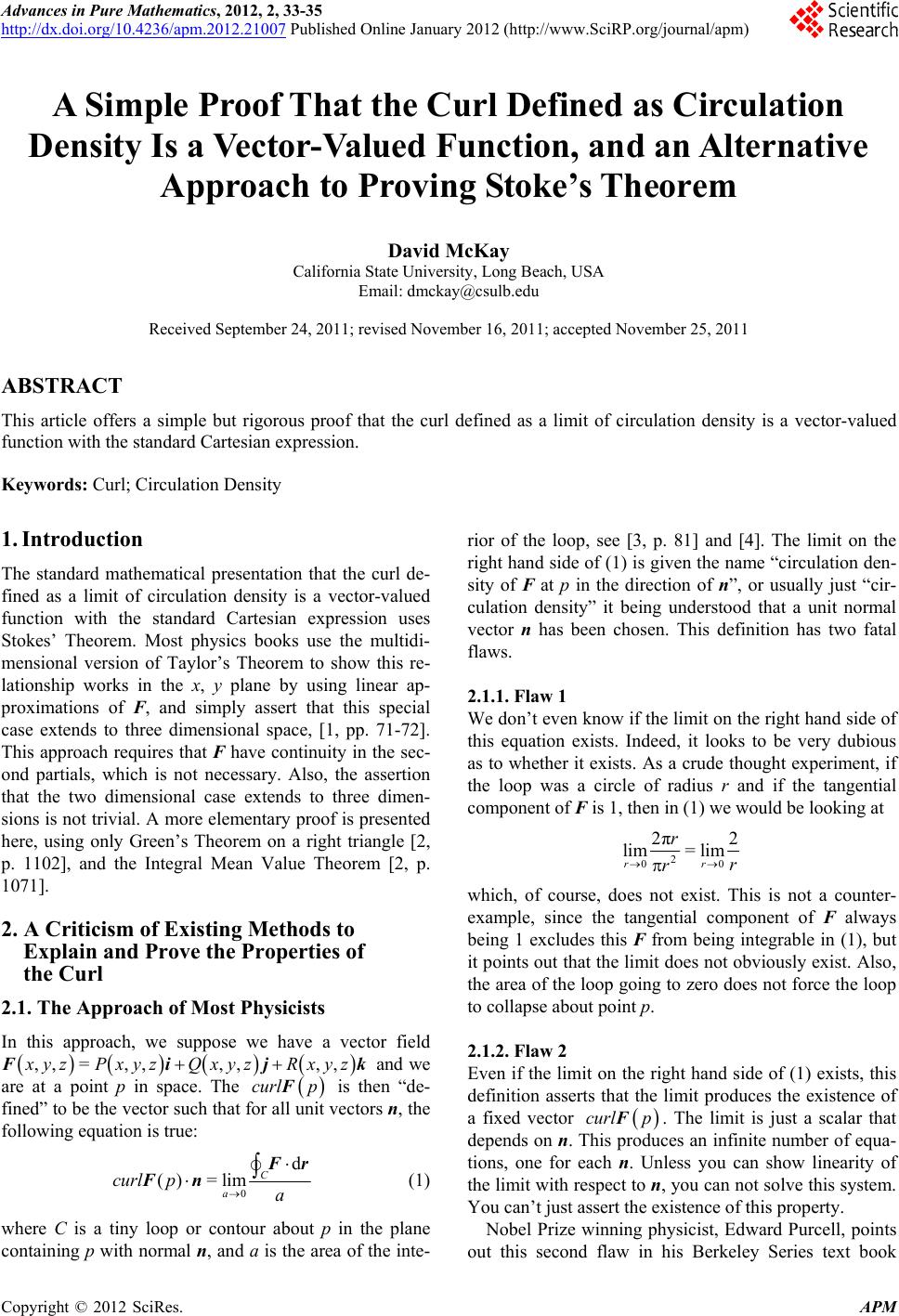
Advances in Pure Mathematics, 2012, 2, 33-35
http://dx.doi.org/10.4236/apm.2012.21007 Published Online January 2012 (http://www.SciRP.org/journal/apm)
A Simple Proof That the Curl Defined as Circulation
Density Is a Vector-Valued Function, and an Alternative
Approach to Proving Stoke’s Theorem
David McKay
California State University, Long Beach, USA
Email: dmckay@csulb.edu
Received September 24, 2011; revised November 16, 2011; accepted November 25, 2011
ABSTRACT
This article offers a simple but rigorous proof that the curl defined as a limit of circulation density is a vector-valued
function with the standard Cartesian expression.
Keywords: Curl; Circulation Density
1. Introduction
The standard mathematical presentation that the curl de-
fined as a limit of circulation density is a vector-valued
function with the standard Cartesian expression uses
Stokes’ Theorem. Most physics books use the multidi-
mensional version of Taylor’s Theorem to show this re-
lationship works in the x, y plane by using linear ap-
proximations of F, and simply assert that this special
case extends to three dimensional space, [1, pp. 71-72].
This approach requires that F have continuity in the sec-
ond partials, which is not necessary. Also, the assertion
that the two dimensional case extends to three dimen-
sions is not trivial. A more elementary proof is presented
here, using only Green’s Theorem on a right triangle [2,
p. 1102], and the Integral Mean Value Theorem [2, p.
1071].
2. A Criticism of Existing Methods to
Explain and Prove the Properties of
the Curl
2.1. The Approach of Most Physicists
In this approach, we suppose we have a vector field
,, =,,,,
,,
yz PxyzQxyzFiRxyzjk
curl pF and we
are at a point p in space. The is then “de-
fined” to be the vector such that for all unit vectors n, the
following equation is true:
0
d
=limC
aa
Fr
()curlp Fn (1)
where C is a tiny loop or contour about p in the plane
containing p with normal n, and a is the area of the inte-
rior of the loop, see [3, p. 81] and [4]. The limit on the
right hand side of (1) is given the name “circulation den-
sity of F at p in the direction of n”, or usually just “cir-
culation density” it being understood that a unit normal
vector n has been chosen. This definition has two fatal
flaws.
2.1.1. Fl aw 1
We don’t even know if the limit on the right hand side of
this equation exists. Indeed, it looks to be very dubious
as to whether it exists. As a crude thought experiment, if
the loop was a circle of radius r and if the tangential
component of F is 1, then in (1) we would be looking at
2
00
2π2
lim= lim
rr
r
r
r
which, of course, does not exist. This is not a counter-
example, since the tangential component of F always
being 1 excludes this F from being integrable in (1), but
it points out that the limit does not obviously exist. Also,
the area of the loop going to zero does not force the loop
to collapse about point p.
2.1.2. Fl aw 2
Even if the limit on the right hand side of (1) exists, this
definition asserts that the limit produces the existence of
a fixed vector
curl pF. The limit is just a scalar that
depends on n. This produces an infinite number of equa-
tions, one for each n. Unless you can show linearity of
the limit with respect to n, you can not solve this system.
You can’t just assert the existence of this property.
Nobel Prize winning physicist, Edward Purcell, points
out this second flaw in his Berkeley Series text book
C
opyright © 2012 SciRes. APM